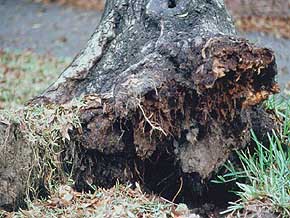Home > Root growth > Root collar exam and treatments > Root rot
Root rot
After removing soil from the base of the tree look for four or more main woody roots intact with bark. Decay should not be present in the main support roots. Root decay is shown in the right photo. Test this by attempting to insert a sharp small diameter implement into the wood. Professional arborists have specialized small-diameter drills and bits for this purpose.
Main roots should be more-or-less straight out from the trunk, not deflected or turned. Rotted, deflected, circling, or turned roots can reduce the stability of the tree. Trees can be considered a high risk if more than one third of the main buttress roots are missing. A missing root is one that has less sound wood than trunk dbh times 0.15.
Treatment: Consider reducing the size of the tree or thinning the canopy to reduce the likelihood of the tree falling in wind storms. Tree removal is recommended if the tree is large and many buttress roots are decayed. Many full canopied trees fall over in storms due to a weak, decayed root system.

